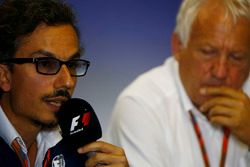Analysis: Six key questions about Halo answered
Confirmation from the FIA that the Halo will be fitted to Formula 1 cars in 2018 has caused quite a stir, with many fans stating their outright opposition, and both current and past drivers voicing doubts.

Photo by: XPB Images
































Some have questioned the principle of open-wheel racing cars being equipped with such a device, referring to the DNA of the sport as one that has always involved some risk, and to the detrimental effect on the looks of the cars.
Others have questioned its effectiveness, and suggested that it creates new problems.
One thing that is definitely wrong is the idea that its introduction is a "knee-jerk" reaction, with those suggesting that it is perhaps influenced by the timing of the confirmation.
It came just after Sebastian Vettel's brief run with the Shield at Silverstone, leading critics to think that the alternative to Halo had been hastily abandoned without being properly considered.
In fact, the Shield has not passed the required impact tests, and far from being rushed in, the Halo has been subject to years of work, spearheaded by FIA safety director Laurent Mekies and his research team.
So how does the Frenchman address about the key questions that many people have about the Halo?
1. Will it really contribute to safety?
The impetus for the Halo came in essence from flying wheel accidents, and that's how both it and other possible solutions have been tested.
"We were trying to protect at least the driver's head, the cockpit being impacted by a wheel," says Mekies.
"And we picked a speed that we felt was a larger possibility – which was 225km/h. So that is what we have tried to pass with all these devices, are they able to protect the drivers against an impact at 225km/h?"
However, its benefits are much more extensive. The FIA has analysed three different scenarios: car-to-car collisions, car-to-environment contact, and external factors, such as wheels and debris.
In all those cases, past accidents, mainly from F1 but also from other categories, were studied, in order to see what difference the Halo would have made.
The car-to-car incidents analysed were those where one car had landed on top of the cockpit of another, including the Romain Grosjean/Fernando Alonso first corner collision at Spa.
Those involving the environment included accidents where cars went under tyre barriers, with examples including Luciano Burti at Spa and Heikki Kovalainen in Barcelona, or rolled along the top of them, such as Ernesto Viso's GP2 crash at Magny-Cours.
The study even included Pascal Wehrlein's incident at Monaco this year – new pictures from the FIA's cockpit camera showed how close the German's helmet was to the barrier while he waited for the car to be righted.
"We played the 'what if?' scenario," says Mekies. "We fitted the Halo onto the car, and we simulated these accidents, and tried not only to simulate that very single accident scenario, but also around that scenario. We tried to look at 5cms above, 10cms above, 5cms to the right, 10cms to the right, and so on.
"At the end of that for each of these cases we then looked at if it was very positive, neutral, or negative. The number of scenarios in which the Halo would have helped is overwhelming compared with the number of scenarios where it could have been neutral or negative."
All the cases detailed in the FIA presentation to the drivers and media were either positive, positive on balance, or neutral – with Jules Bianchi's Suzuka crash among the few categorised as the latter. None came out as negative, although Mekies acknowledges that the FIA can never rule out such an outcome.
As noted earlier, the main purpose of the Halo is to deal with flying objects – and to that end it's important to note that the FIA has determined that it would have had a positive outcome in the cases of Henry Surtees and Justin Wilson.
The FIA also acknowledges that it can't provide complete protection against smaller items of debris, such as the suspension spring that struck Felipe Massa in Hungary. However, tests have shown that its presence significantly improves a driver's chances.
"We looked at mathematical studies whereby we played the game of throwing millions of small objects to the Halo from all different angles, and all different positions.
"Statistically when you put the structure in front of the driver you are going to increase his protection against small debris coming to hit him, compared to not having the Halo."
2. Will visibility will be a major problem?
Inevitably many people believe that visibility will be an issue, and some drivers expressed doubts after their brief test runs last year. However, the FIA is confident that the view ahead will be sufficient.
It has compared an F1 car equipped with a Halo with an LMP1 windscreen, which is typically very restricted – even though the governing body has mandated a minimum field of vision.
"We tried the Halo with all teams, and pretty much with all drivers," Mekies notes. "A very large majority of drivers were satisfied with visibility.
"We did have an issue with feedback from one or two drivers that had a bit of a claustrophobic feeling the first time they ran, with that shape ahead of them. But we were comfortable that we can deal with all that.
"With an LMP1 we had the opposite problem. The FIA imposed a minimum field of vision to the manufacturers, otherwise they would design cars that basically would barely allow the drivers to see through. We are very comfortable with the fact that we are offering much better visibility than in other categories."
The FIA is also working to shrink the width of the central pillar of the Halo for next year, reducing the potential distraction for the drivers.
"The central strut is currently 20mm. We feel that we have scope to reduce that thickness for the benefit of the drivers' forward vision. So we will be testing before next year, going as low as 16mm, and see how much we can push it."
3. Is it harder for drivers to get out of the car?
When they tried the Halo last year, some drivers found getting out of the cockpit wasn't easy – but that was mainly because they couldn't use it to push themselves out, as the dummy Halos employed at the time were not intended to deal with their body weight. The real Halo can be used for that purpose.
"Standard egress was pretty much not an issue," says Mekies. "One driver felt that it would be a critical issue.
"The dominating factor there was when we tested the Halo, 95 percent of them were non-structural, so the drivers could not pull on them to get out of car. And therefore you end up in rather awkward situations."
As for accidents, tests have shown that a standard extraction by marshals, with the driver lifted out still attached to his seat, is actually pretty straightforward – the Halo opening mirrors the opening of the cockpit template beneath it.
4. Will drivers be trapped if a car overturns?
There's a widespread belief that drivers could find themselves trapped by the Halo if a car turns over, with Fernando Alonso's accident in the 2016 Australian GP an oft-cited case. Mekies points out that marshals are trained to right any upside down car.
"As Charlie [Whiting] always reminds us, the standard procedure for this is that the car should be pushed back on its wheels by the marshals, that's what we are aiming to do. But nevertheless we wanted see what would happen."
The FIA conducted a simple test with a dummy chassis, with its own safety expert Andy Mellor strapped in.
When the chassis was tipped upside down the Halo kept the front of the chassis higher off the ground than it would normally be, and Mellor had no trouble getting himself out. At a recent briefing drivers were shown a video of the test.
"In fact, it is actually preserving a better space for drivers," says Mekies. "Because the car is resting on the front part of the Halo, offering more space than they currently have compared to the ground...
"So it's basically raising up the car compared to where it would be without it. When we showed that to the drivers, they felt that it would actually be quite a good training for all of them to go through."
5. What if the Halo is damaged and has to be removed?
In its tests, the FIA determined that there was no scenario where it felt that the Halo might have to be removed after an accident – but nevertheless it has allowed for that possibility.
"We didn't find any scenario where we needed to remove the Halo," says Mekies. "But is that good enough? Are we sure that there is not one scenario where the Halo is going to be completely deformed over the driver's head, and we would want to remove it?
"At first, if this is happening, we would probably all be happy that the Halo was fitted to the car in the first place, because if something deforms that device, you can only imagine what would have been without it.
"We investigated a lot of tools and equipment in order to cut the Halo, and we sourced something that is small enough to fit in our medical car, and would cut the Halo in no time.
"So even in a very extreme scenario that we couldn't exactly picture, we feel that we can cut the Halo in basically no time."
Tests show that it would take two seconds to cut the front pillar, and five seconds apiece to cut the rear-left and rear-right supports.
6. Will the Halo make the cars look ugly?
While no one expects cars fitted with Halo to look as good as they currently do without it, fans are yet to see the definitive devices, which will be fitted with aerodynamic profiles that should improve their appearance.
FIA race director Charlie Whiting says that the prototypes tested on track last season were "raw," and that the addition of fairings allowed under the 2018 rules will mean that they look a lot more attractive next season.
"I think you'll find that teams haven't explored the full range of possibility to make them look a little more pleasing to the eye," Whiting explains.
"At the moment we've only seen bare designs. Even when Williams ran with a white one, the same colour as the car, it looked a lot better, I think you'll agree.
"I personally think fans will get used to it. I know there's a little bit of pushback at the moment. I think they will come up with some pretty different designs, so I don't think it will be quite as bad as you think."
VIDEO: Can Halo be incorporated into livery?
Be part of Motorsport community
Join the conversationShare Or Save This Story
Subscribe and access Motorsport.com with your ad-blocker.
From Formula 1 to MotoGP we report straight from the paddock because we love our sport, just like you. In order to keep delivering our expert journalism, our website uses advertising. Still, we want to give you the opportunity to enjoy an ad-free and tracker-free website and to continue using your adblocker.















Top Comments